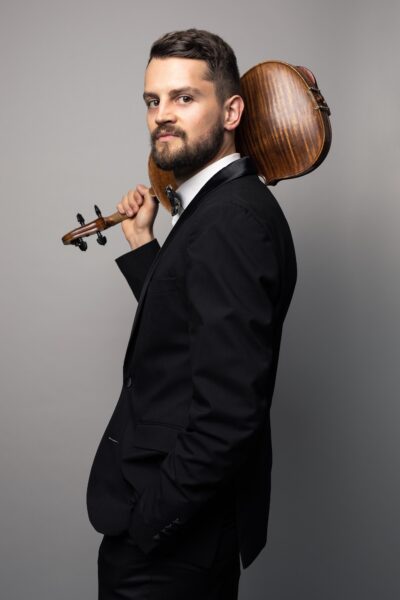 Praised by The WholeNote as “showcasing multitudes of colours and possibilities, with much skill and imagination,” Radia, the moniker for Saskatchewan-raised artist Ryan Davis, is swiftly emerging as a singular creative force. Combining his rigorous classical training with the inspiration of folk, electronic, and hip-hop music, he finds himself seamlessly blending in between creative spaces. Using the viola as his voice, his unique sound has garnered attention and has been featured in diverse spaces, including in Toronto’s Koerner Hall, The Violin Channel, in Los Angeles’s Skid Row, and on ABC Channel 7 News LA. Of Glow & Abandon, his debut EP, was released on all major platforms on December 18th, 2021. He was named one of “30 Hot Canadian Classical Musicians Under 30” by CBC Music in 2021.
Praised by The WholeNote as “showcasing multitudes of colours and possibilities, with much skill and imagination,” Radia, the moniker for Saskatchewan-raised artist Ryan Davis, is swiftly emerging as a singular creative force. Combining his rigorous classical training with the inspiration of folk, electronic, and hip-hop music, he finds himself seamlessly blending in between creative spaces. Using the viola as his voice, his unique sound has garnered attention and has been featured in diverse spaces, including in Toronto’s Koerner Hall, The Violin Channel, in Los Angeles’s Skid Row, and on ABC Channel 7 News LA. Of Glow & Abandon, his debut EP, was released on all major platforms on December 18th, 2021. He was named one of “30 Hot Canadian Classical Musicians Under 30” by CBC Music in 2021.
Ryan will be a featured solo artist with the Saskatoon Symphony Orchestra throughout their 2022-2023 season: a concerto performance on opening night, September 24th; as well as premiering an original work for viola, electronics, and the SSO musicians on April 2nd. He will also be joining The Gryphon Trio for featured performances in Halifax and Vancouver in 2023.
Some recent highlights include an appearance on former Toronto Raptors forward and NBA Champion Serge Ibaka’s Instagram Live show How Talented Are You?, a performance with The Gryphon Trio and vocalist Patricia O’Callaghan as a featured guest artist in Kingston’s Isabel Bader Theatre, a solo curation called Chromatophores as part of the Banff Centre’s Evolution Classical festival, and a performance of Christos Hatzis’s The Mega4 Meta4 as an invited solo artist as part of 21C Music Festival at The Royal Conservatory of Music. Ryan was chosen as the principal violist of the string ensemble Les Jeunes Virtuoses in Montreal, as part of the Montreal Chamber Music Festival in the fall of 2021.
He had a solo concerto debut with ensemble Prairie Virtuosi in January 2016, and has since returned in that role in 2020. Mr. Davis was the principal violist of the Colburn Orchestra’s 2018 tour of Scotland and Ireland, and was selected by the Lucerne Festival Academy Orchestra as their principal violist for the 2017 summer festival. He has been fortunate to collaborate in chamber music settings with many world-renowned musicians, including Martin Beaver, Jonathan Crow, Steven Dann, Roberto Diaz, Mark Fewer, Matt Haimovitz, Charles-Richard Hamelin, Barbara Hannigan, Ernst Kovacic, Joel Link, Anthony Marwood, Johannes Moser, Eric Nowlin, Erika Raum, Wolfgang Redik, Lara St. John, Axel Strauss, and Time For Three. Festivals include the Banff Centre for the Arts, BigLake Arts, Creative Dialogue France, Orford Arts Center, Ottawa Chamberfest, McGill International String Quartet Academy, Napa Valley Music Festival, Ritornello Chamber Music Festival, and the Toronto Summer Music Festival.
Ryan’s passion for community engagement has led to working closely with Street Symphony, focused within the Skid Row neighbourhood of Los Angeles. Along with trombonist Jared Dickerson and violinist Simone Porter, he created the media co-op The Upnote, a platform and podcast focused on the exploration of young artists in an ever-changing music industry. After over 50 episodes, The Upnote was selected as the inaugural Entrepreneurs In Residence at the Colburn School for the 2019-2020 academic year, and were awarded the Grand Prize at the New Venture Competition.
In 2014 Mr. Davis completed a Bachelor of Music degree at McGill University, graduating with “Outstanding Achievement in Viola” as a scholarship student of Andre Roy, and graduated in 2016 with a Master of Music degree from the Yale School of Music as a student of Ettore Causa, and in 2019 graduated from Los Angeles’s The Colburn School, receiving an Artist Diploma under the tutelage of Paul Coletti. Ryan was then chosen as the first ever violist to be selected as a Rebanks Fellow in 2019, in the Rebanks Family Fellowship & International Performance Residency Program in Toronto, where he now calls home.
https://www.ryandavisviola.com/


 Praised by The WholeNote as “showcasing multitudes of colours and possibilities, with much skill and imagination,” Radia, the moniker for Saskatchewan-raised artist Ryan Davis, is swiftly emerging as a singular creative force. Combining his rigorous classical training with the inspiration of folk, electronic, and hip-hop music, he finds himself seamlessly blending in between creative spaces. Using the viola as his voice, his unique sound has garnered attention and has been featured in diverse spaces, including in Toronto’s Koerner Hall,
Praised by The WholeNote as “showcasing multitudes of colours and possibilities, with much skill and imagination,” Radia, the moniker for Saskatchewan-raised artist Ryan Davis, is swiftly emerging as a singular creative force. Combining his rigorous classical training with the inspiration of folk, electronic, and hip-hop music, he finds himself seamlessly blending in between creative spaces. Using the viola as his voice, his unique sound has garnered attention and has been featured in diverse spaces, including in Toronto’s Koerner Hall, 
